Part 1: Questionable Doctrine Of JW: Did Jesus Die On A Cross Or Stake? - Religion - Nairaland
Nairaland Forum / Nairaland / General / Religion / Part 1: Questionable Doctrine Of JW: Did Jesus Die On A Cross Or Stake? (2558 Views)
The False Doctrine Of Eternal Torment And Judgement After Death(sleep) / Can Jesus Die For Our Sins? / The Doctrine Of The Ufos (2) (3) (4)
| Part 1: Questionable Doctrine Of JW: Did Jesus Die On A Cross Or Stake? by ChristianFreedo(m): 2:41pm On Sep 22, 2016 |
Did Jesus Die on a Cross or Stake? NB: All quotations from watchtower publications, including the New World Translation are in blue. Watchtower claims Jesus died on a stake, on the basis that Staurous did not mean Cross until "later" than Jesus' time. This is incorrect, and all evidence points to Jesus' death being on a cross. The positioning of Jesus' hands at death is purely academic 1. However, It has become an issue because Jehovah's Witnesses view the cross as one of the identity of false Christianity(Religion). The cross becomes an ongoing form of reinforcement that Jehovah's Witnesses have truth and Christendom is reserved for destruction, as indicated in the following quote of May 1, 1989 Watchtower, page 23: "There are also inanimate objects that if venerated may lead to breaking God's commandments. Among the most prominent is the cross. For centuries it has been used by people in Christendom as part of their worship. Soon God will execute his judgments against all false religions. Those who cling to them will suffer their fate." Watchtower makes the claim that Jesus died on a stake and that the cross is a pagan, idolatrous symbol. These claims are unfounded and this section presents some of the ample evidence that Jesus died on a cross. Paul shows the cross (or whatever instrument of Jesus' execution) is not only acceptable but an important part of Christianity. 1 Corinthians 1:17-18 "For Christ dispatched me, not to go baptizing, but to go declaring the good news, not with wisdom of speech, that the torture stake [cross] of the Christ should not be made useless. For the speech about the torture stake [cross] is foolishness to those who are perishing, but to us who are being saved it is God's power." For over 50 years, Watchtower used the cross and taught that Jesus died on a cross. "Jesus was crucified upon the cross" Life (1929) p.216 "The cross of Christ is the greatest pivotal truth of the divine arrangement, from which radiate the hopes of men." The Harp of God (Rutherford) p.141 Up until the October 1st 1931 edition, the cross and crown symbol was included on The Watch Tower cover. 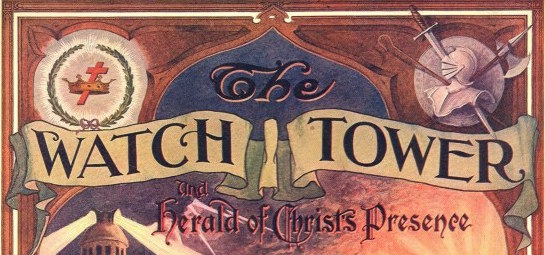 It was not until well into the time of Rutherford that the anti-cross teaching was developed. Rutherford started to promote the view of several Protestant preachers that the word stauros was not known as cross until Constantine introduced it 300 years after Jesus death. In 1934, The Golden Age 2 Feb 28 p.336 quoted from Guy Thorne's book When It Was Dark, to claim the Cross is of pagan origins. A main source for Rutherford, and used by Watchtower to this day, became E. W. Bullinger's 1921 Appendix 162 to The Companion Bible. Rutherford argued that Constantine introduced the cross 300 years after Jesus' death to make Christianity more appealing to pagans that were using the cross as a symbol. This article shows that current Watchtower information on the cross is incorrect. Rutherford relied on incorrect information that is not borne out by history. There is ample evidence that in Jesus' time stauros could refer to a cross, the cross was a common form of torture, and Christians were identified by the symbol of a cross 200 years prior to Constantine. Most importantly, Scriptural references to Jesus' death help identify that he was on a cross. Footnote: 1. Should be irrelevant in practice, especially in gaining salvation. 2. Now known as Awake!
|
| Re: Part 1: Questionable Doctrine Of JW: Did Jesus Die On A Cross Or Stake? by ChristianFreedo(m): 2:46pm On Sep 22, 2016 |
Biblical References Scriptural references to Jesus death indicate that he died on a cross, not a stake. The accounts at Matthew 27:26, 31-37, Mark 15:14-26, Luke 23:26-38, and John 19:1-22 all show that Jesus was forced to follow the practice of carrying the stauron to Golgotha. As seen from Dionysius quoted later, it was a Roman practice for the victim to carry the crossbeam, or patibulum to site of execution. There the patibulum was affixed to an upright stake. John 19:17 "And, bearing the torture stake for himself, (bastazón hautó ton stauron), he went out to the so-called Skull Place, which is called Gol´go·tha in Hebrew." A further indication of whether Jesus died on a cross or a stake can be seen by a comparison of the following picture with what is stated in the Bible. 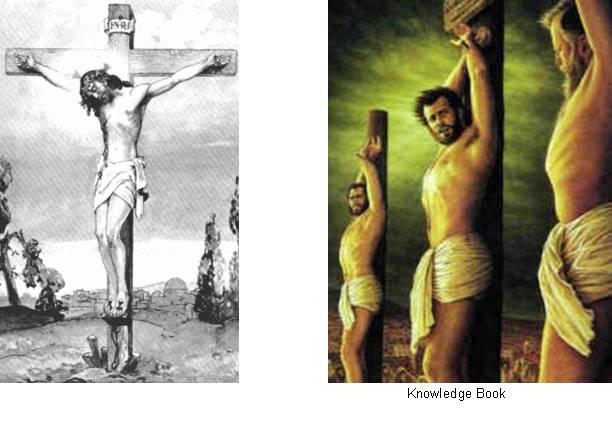 Look at the number of nails in each picture. Notice in the above depiction from the Watchtower publication Knowledge That Leads to Everlasting Life there is only one nail and it goes through the wrist and not the hands, due to it being a stake, not a cross. Compare this to what Thomas stated at John 20:25; "unless I see in his hands the print of the nails and stick my finger into the print of the nails and stick my hand into his side, I will certainly not believe". Jesus was crucified with two nails, one in each hand, not a single nail through the wrist. That separate nails were in each hand is made clear by the use of the word 'nails' not 'nail'. This suggests that Jesus had his arms separated on a cross, not together on a stake as represented in Watchtower publications. Matthew 27:37 also supports the idea of a cross rather than a stake when it says; "Above his head they had put the charge against him in writing: 'THIS IS JESUS, KING OF THE JEWS' ". In the picture of the crucifixion the plaque is above Jesus head, whereas in the Watchtower representation it is necessarily above his hands. If Jesus were impaled on a stake it would be stated that the titilus was placed above his hands, not his head. J. H. Bernard observes that this scripture "suggests that the cross was of the shape called crux immissa, with a cross-bar for the arms, as painters have generally represented it to be" (A Critical & Exegetical Commentary on the Gospel According to St. John, 1929, Vol. 2, p. 628). Ante-Nicene Fathers 1 Watchtower claims: "Not until the fourth century C.E. did the cross begin coming into noticeable use among professed Christians. The one primarily responsible for this development was Emperor Constantine, a sun worshiper who is said to have accepted Christianity years before submitting to baptism while on his deathbed." Awake! 1972 Nov 8 p. 27 The Awake! does not provide any evidence to support this assertion and it is quite untrue, even shown to be so in other Awake! editions. "But do not writers early in the Common Era claim that Jesus died on a cross? For example, Justin Martyr (114-167 C.E.) described in this way what he believed to be the type of stake upon which Jesus died: "For the one beam is placed upright, from which the highest extremity is raised up into a horn, when the other beam is fitted on to it, and the ends appear on both sides as horns joined on to the one horn." This indicates that Justin himself believed that Jesus died on a cross. However, Justin was not inspired by God, as were the Bible writers." Awake! 1976 Nov 22 p.27 Writings about the cross trace back to the early days of Christianity. From the Epistle of Barnabas (~100 C.E.): "the cross was to express the grace [of our redemption] by the letter." "Here again you have an intimation concerning the cross, and Him who should be crucified in Moses, when Israel was attacked by strangers the Spirit speaks to the heart of Moses, that he should make a figure of the cross, and of Him about to suffer thereon Moses therefore placed one weapon above another in the midst of the hill, and standing upon it, so as to be higher than all the people, he stretched forth his hands." Justin Martyr was born at the time John is said to have written the account of Jesus death and wrote his apologies around 155 A.D. His descriptions of the death of Jesus identify that a cross was used. It shows that the cross was not introduced to Christianity 300 years after Jesus death by Constantine, but was already used as early as the second century. In Second Apology, chapter VI he talks of "Jesus Christ, who was crucified under Pontius Pilate." In Chapter XL he goes on to liken Jesus to the sacrificial lamb of the Passover. "God does not permit the lamb of the passover to be sacrificed in any other place than where His name was named; knowing that the days will come, after the suffering of Christ, when even the place in Jerusalem shall be given over to your enemies, and all the offerings, in short, shall cease; and that lamb which was commanded to be wholly roasted was a symbol of the suffering of the cross which Christ would undergo. For the lamb,(1) which is roasted, is roasted and dressed up in the form of the cross. For one spit is transfixed right through from the lower parts up to the head, and one across the back, to which are attached the legs of the lamb." In the First Apology Chapter XXXV Justin's description shows that Jesus dying on a cross was in fulfilment of prophecies that said he would 'spread out his hands', as Barnabas also stated as quoted above, and also that he would bear God's Kingdom 'on his shoulders'; "There are the following predictions:--"Unto us a child is born, and unto us a young man is given, and the government shall be upon His shoulders;" which is significant of the power of the cross, for to it, when He was crucified, He applied His shoulders, as shall be more clearly made out in the ensuing discourse. And again the same prophet Isaiah, being inspired by the prophetic Spirit, said, "I have spread out my hands to a disobedient and gainsaying people, to those who walk in a way that is not good. They now ask of me judgment, and dare to draw near to God." And again in other words, through another prophet, He says, "They pierced My hands and My feet, and for My vesture they cast lots." And indeed David, the king and prophet, who uttered these things, suffered none of them; but Jesus Christ stretched forth His hands, being crucified by the Jews speaking against Him, and denying that He was the Christ." Further in CHAPTER LV -- SYMBOLS OF THE CROSS Justin continues: "But in no instance, not even in any of those called sons of Jupiter, did they imitate the being crucified; for it was not understood by them, all the things said of it having been put symbolically. And this, as the prophet foretold, is the greatest symbol of His power and role; as is also proved by the things which fall under our observation. For consider all the things in the world, whether without this form they could be administered or have any community. For the sea is not traversed except that trophy which is called a sail abide safe in the ship; and the earth is not ploughed without it: diggers and mechanics do not their work, except with tools which have this shape. And the human form differs from that of the irrational animals in nothing else than in its being erect and having the hands extended, and having on the face extending from the forehead what is called the nose, through which there is respiration for the living creature; and this shows no other form than that of the cross. And so it was said by the prophet, "The breath before our face is the Lord Christ." And the power of this form is shown by your own symbols on what are called "vexilla" [banners] and trophies, with which all your state possessions are made, using these as the insignia of your power and government, even though you do so unwittingly. And with this form you consecrate the images of your emperors when they die, and you name them gods by inscriptions. Since, therefore, we have urged you both by reason and by an evident form, and to the utmost of our ability, we know that now we are blameless even though you disbelieve; for our part is done and finished." The sails on Roman boats had crossbeams  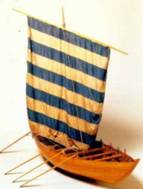 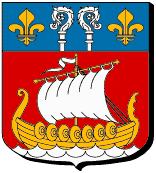 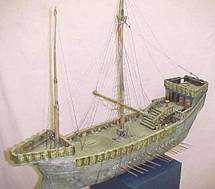 A Roman vexilla and vexilla flag, both showing the crossbeam 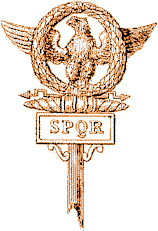 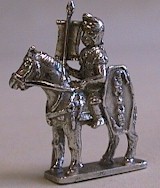 Tertullian clearly identifies the use of a cross in his writings dating from A.D. 190-220 "You hang Christians on crosses (crucibus) and stakes (stipitibus); what idol is there but is first moulded in clay, hung on a cross and stake (cruci et stipiti)? It is on a patibulum that the body of your god is first dedicated" (Apologeticus, 12.3). "For this same letter TAU of the Greeks, which is our T, has the appearance of the cross (crucis)" (Apologeticus, 3.23.6) "Every stake fixed in an upright position is a portion of the cross; we render our adoration, if you will have it so, to a god entire and complete. We have shown before that your deities are derived from shapes modelled from the cross. But you also worship victories, for in your trophies the cross is the heart of the trophy. The camp religion of the Romans is all through a worship of the standards, a setting the standards above all gods. Well, as those images decking out the standards are ornaments of crosses. All those hangings of your standards and banners are robes of crosses. I praise your zeal: you would not consecrate crosses unclothed and unadorned." (Apologeticus, 16) Irenaeus (130 - 200 A.D.) wrote that the implement of Jesus death had five ends: two longitudinal, two latitudinal and a fifth to support the weight of the victim. ("Fines et summitates habet quinque, duas in longitudine, duas in latitudine, unam in medio." Adv. Haer., II, xxiv) Longitudinal and latitudinal ends refer to a cross. The fifth was the sedile or sedulum, a piece of wood placed below the victims feet so that they could raise the body to relieve pressure off the chest and hence prolong the time taken to die. At jewishencyclopedia.com/view.jsp?artid=899&letter=C (as of 2nd Jan 2015) an article by Kaufmann Kohler on the cross gives the following references to Ante Nicene works that show the Cross was commonly used by the second century. "The cross as a Christian symbol or "seal" came into use at least as early as the second century (see "Apost. Const." iii. 17; Epistle of Barnabas, xi.-xii.; Justin, "Apologia," i. 55-60; "Dial. cum Tryph." 85-97); and the marking of a cross upon the forehead and the chest was regarded as a talisman against the powers of demons (Tertullian, "De Corona," iii.; Cyprian, "Testimonies," xi. 21-22; Lactantius, "Divinæ Institutiones," iv. 27, and elsewhere). Accordingly the Christian Fathers had to defend themselves, as early as the second century, against the charge of being worshipers of the cross, as may be learned from Tertullian, "Apologia," xii., xvii., and Minucius Felix, "Octavius," xxix. Christians used to swear by the power of the cross (see Apocalypse of Mary, viii., in James, "Texts and Studies," iii. 118)." Footnotes: 1. The Ante-Nicene Fathers, subtitled "The Writings of the Fathers Down to A.D. 325", is a collection of books in 10 volumes (one volume is indexes) containing English translations of the majority of Early Christian writings. The period covers the beginning of Christianity until before the promulgation of the Nicene Creed at the First Council of Nicaea. The translations are very faithful, and provide valuable insights into the spirituality and theology of the early Church fathers. |
| Re: Part 1: Questionable Doctrine Of JW: Did Jesus Die On A Cross Or Stake? by ChristianFreedo(m): 2:47pm On Sep 22, 2016 |
Archaeology In 1856 R. Garrucci discovered a caricature of the crucified Jesus on the walls of the Paedagogium, on the slopes of Palatine Hill in Rome. According to Jack Finegan, "this crude graffito shows a man's body with an ass's head, on a cross. The feet are supported on a platform and the outstretched arms fastened to the transverse bar of the cross. To the left is a smaller figure of a boy or young man in an attitude of adoration" (Light From the Ancient Past 1959 p.373). This graffiti is thought to date sometime between AD 161-235. 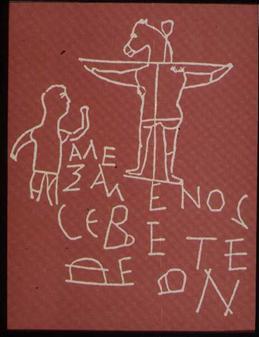 Tertullian wrote of a similar cartoon in his Apologeticus: "A new representation of our god has quite recently been publicized in this city, started by a certain criminal hired to dodge wild beasts in the arena. He displayed a picture with this inscription: 'Onokoites, the god of the Christians'. The figure had the ears of an ass, one foot was cloven, and it was dressed in a toga and carrying a book. We laughed at both the caption and the cartoon" (Apologeticus, 16.12-14). Archaeological finds also show that the cross was a means of death at the time of Jesus. "The first century catacomb uncovered by archaeologist P. Bagatti on the Mount of Olives contains inscriptions clearly indicating its use, 'by the very first Christians in Jerusalem.' ... 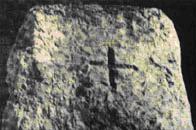 A "head stone", found near the entrance to the first century catacomb, is inscribed with the sign of the cross. ... Both archaeologists found evidence clearly dating the two catacombs to the first century AD, with the later finding coins minted by Governor Varius Gratus at the turn of the millenium (up to 15/16 AD). Evidence in both catacombs indicated their use for burial until the middle part of the first century AD, several years before the New Testament was written." Jerusalem Christian Review, Volume 9, Internet Edition, Issue 2 "Jerusalem Burial Cave Reveals: Names, Testimonies of First Christians" Jean Gilman. (See leaderu.com/theology/burialcave.html as of 2nd Jan 2015) A house in Herculaneum, buried in the 79 A.D. Mt. Vesuvius eruption, contains an imprint of a traditional Roman cross. (Maier, P.L., "First Christians: Pentecost and the Spread of Christianity," Harper & Row: New York, 1976, p.141). 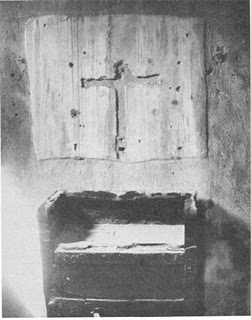 Early editions (1950 and 1969) of the New World Translation had said, "The passing of time and further archaeological discoveries will be certain to prove its (the stakes) correctness...." This statement does not appear in the 1984 and 1985 versions of the New World Translation, possibly indicating that the Organization was aware that later excavations reveal proof for the cross, such as described in the Biblical Archaeology Review Jan/Feb 1985 edition as follows. From ancient literary sources we know that tens of thousands of people were crucified in the Roman Empire. In Palestine alone, the figure ran into the thousands. Yet until 1968 not a single victim of this horrifying method of execution had been uncovered archaeologically. In that year I excavated the only victim of crucifixion ever discovered. He was a Jew, of a good family, who may have been convicted of a political crime. He lived in Jerusalem shortly after the turn of the era and sometime before the Roman destruction of Jerusalem in 70 A.D. (Crucifixion—The Archaeological Evidence Link active as of 2nd Jan 2015) The Biblical Archaeology Review describes in detail the agonising process of death by crucifixion. "During this early period, a wooden beam, known as a "patibulum" was placed on the slave's neck and bound to his arms. The slave was then required to march through the neighborhood proclaiming his offense. Later, the slave was also stripped and scourged, increasing both the punishment and the humiliation. Ahead of the march to the execution site was a soldier carrying the "titulus," an inscription written on wood, which stated the defendant's name and the crime for which he had been condemned. When the procession arrived at the execution site, a vertical stake was forced into the ground. The victim was attached to the "patibulum" and stake either with ropes or nails. In order to prolong the agony, Roman executioners devised two instruments that would keep the victim alive on the cross for extended periods of time. One, known as a "sedile," was a small seat attached to the front of the cross, about halfway down. Both Irenaus and Justin Martyr, early church fathers, describe the cross of Jesus as having five extremities rather than four; the fifth was probably the "sedile"." Biblical Archaeology Review Jan/Feb 1985 pp.48-49 The staurogram  is an early pictograph of Jesus on the cross, created by superimposing tau (Τ) on rho (Ρ). This dates back earlier than 200 A.D., and was used in Bible Manuscripts, such as the New Testament Bodmer papyrus P75 in the Greek words for “cross” (stauros) and “crucify” (stauroō). is an early pictograph of Jesus on the cross, created by superimposing tau (Τ) on rho (Ρ). This dates back earlier than 200 A.D., and was used in Bible Manuscripts, such as the New Testament Bodmer papyrus P75 in the Greek words for “cross” (stauros) and “crucify” (stauroō).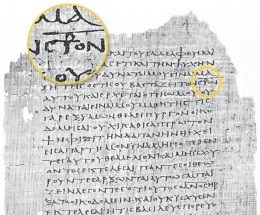 See “The Staurogram: Earliest Depiction of Jesus’ Crucifixion” by Larry Hurtado in the Biblical Archaeology Review 2013 March/April. |
| Re: Part 1: Questionable Doctrine Of JW: Did Jesus Die On A Cross Or Stake? by ChristianFreedo(m): 2:48pm On Sep 22, 2016 |
Medical evidence The Romans choice of using a cross over a stake was apparently due to the cross being able to extend the time it takes a person to die. By staying alive for hours or days the crucified person served as a warning example to others. The site centuryone.org/crucifixion2.html (February 15 2006) looks at some of these issues. Quoting research contained at F.T. Zugibe, 1984 Death by Crucifixion, Canadian Society of Forensic Science 17(1):1-13.6 it shows that on a cross, rather than a rapid death from asphyxiation death it can take hours or days to die from hypovolemic shock. On the other hand, death on a stake is rapid. Summarising research by P. Barbet 1953 Les Cinq Plaies du Christ 2nd ed. Paris: Procure du Carmel de l' Action de Graces; "Eye Witness accounts by prisoners of war in Dacchu during WWII reported that victims suspended from beams by their wrist, which were tied, expired within ten minutes if their feet were weighted or tied down and within one hour if their feet were unweighted and the victim was able to raise and lower himself to permit respiration. Death in this manner, which is one form of crucifixion, was the result of suffocation." The length of time Jesus and the other two survived after impalement shows they were likely supported on a cross by a sedile. History In Jesus day there were many forms of impaling, with the cross being the most common form used by the Romans. The reason Romans used the cross was they perfected it as one of the most extreme forms of torture. In regards to the history of the crucifixion The JAMA - Journal of the American Medical Association, March 21, 1986, Volume 255; Copyright 1986, American Medical Association states: "...Crucifixion probably first began among the Persians. Alexander the Great introduced the practice to Egypt and Carthage, and the Romans appear to have learned of it from the Carthaginans. Although the Romans did not invent crucifixion, they perfected it as a form of torture and capital punishment that was designed to produce a slow death with maximum pain and suffering. It was one of the most disgraceful and cruel methods of execution and usually was reserved only for slaves, foreigners, revolutionaries, and the vilest of criminals. ... Only later was a true cross used; it was characterized by an upright post (stipes) and a horizontal crossbar (patibulum), and it had several variations. Although archaeological and historical evidence strongly indicates that the low Tau cross was preferred by the Romans in Palestine at the time of Christ, crucifixion practices often varied in a given geographic region and in accordance with the imagination of the executioners, and the Latin cross and other forms also may have been used. It was customary for the condemned man to carry his own cross from the flogging post to the site of crucifixion outside the city walls. He was usually naked, unless this was prohibited by local customs. Since the weight of the entire cross was probably well over 136 kg, only the crossbar was carried. The patibulum, weighing 34 to 57 kg, was placed across the nape of the victim's neck and balanced along both shoulders. Usually, the outstretched arms then were tied to the crossbar. The processional to the site of crucifixion was led by a complete Roman military guard, headed by a centurion. One of the soldiers carried a sign (titulus) on which the condemned man's name and crime were displayed. Later, the titulus would be attached to the top of the cross. The Roman guard would not leave the victim until they were sure of his death. Outside the city walls was permanently located the heavy upright wooden stipes, on which the patibulum would be secured. In the case of the Tau cross, this was accomplished by means of a mortise and tenon joint, with or without reinforcement by ropes. To prolong the crucifixion process, a horizontal wooden block or plank, serving as a crude seat (sedile or sedulum), often was attached midway down the stipes. Only very rarely, and probably later than the time of Christ, was an additional block (suppedaneum) employed for transfixion of the feet." There are many pre-Christian references that indicate the cross was being used prior to the time of Jesus. These references show that it was a common practice for the victim to carry to crossbeam, or patibulum to their execution. In the first century B.C. Dionysius of Halicarnassus described the practice of tying the patibulum across the victims back: "A Roman citizen of no obscure station, having ordered one of his slaves to be put to death, delivered him to his fellow-slaves to be led away, and in order that his punishment might be witnessed by all, directed them to drag him through the Forum and every other conspicuous part of the city as they whipped him, and that he should go ahead of the procession which the Romans were at the time conducting in honour of the god. The men ordered to lead the slave to his punishment, having stretched out both hands and fastened them to a piece of wood (tas kheiras apoteinantes amphoteras kai xuló prosdésantes) which extended across his chest and shoulders as far as his wrists, followed him, tearing his naked body with whips" (Roman Antiquities, 7.69.1-2)." This is an explicit reference to the Roman practice of patibulum-bearing, likewise mentioned in works written prior to Jesus time by Plautus, Plutarch and Clodius Licinus. At jewishencyclopedia.com/view.jsp?artid=905&letter=C (January 10 2006) Kaufmann Kohler describes crucifixion and shows this practice was used 100 years before the death of Jesus; "The crosses used were of different shapes. Some were in the form of a T, others in that of a St. Andrew's cross, X, while others again were in four parts, +. The more common kind consisted of a stake ("palus"  firmly embedded in the ground ("crucem figere" firmly embedded in the ground ("crucem figere" before the condemned arrived at the place of execution (Cicero, "Verr." v. 12; Josephus, "B. J." vii. 6, § 4) and a cross-beam ("patibulum" before the condemned arrived at the place of execution (Cicero, "Verr." v. 12; Josephus, "B. J." vii. 6, § 4) and a cross-beam ("patibulum" , bearing the "titulus"-the inscription naming the crime (Matt. xxvii. 37; Luke xxiii. 38; Suetonius, "Cal." 38). It was this cross-beam, not the heavy stake, which the condemned was compelled to carry to the scene of execution (Plutarch, "De Sera Num. Vind." 9; Matt. ib.; John xix. 17; See Cross). The cross was not very high, and the sentenced man could without difficulty be drawn up with ropes ("in crucem tollere, agere, dare, ferre" , bearing the "titulus"-the inscription naming the crime (Matt. xxvii. 37; Luke xxiii. 38; Suetonius, "Cal." 38). It was this cross-beam, not the heavy stake, which the condemned was compelled to carry to the scene of execution (Plutarch, "De Sera Num. Vind." 9; Matt. ib.; John xix. 17; See Cross). The cross was not very high, and the sentenced man could without difficulty be drawn up with ropes ("in crucem tollere, agere, dare, ferre" . His hands and feet were fastened with nails to the cross-beam and stake (Tertullian, "Adv. Judæos," 10; Seneca, "Vita Beata," 19); though it has been held that, as in Egypt, the hands and feet were merely bound with ropes (see Winer, "B. R." i. 678). The execution was always preceded by flagellation (Livy, xxxiv. 26; Josephus, "B. J." ii. 14, § 9; v. 11, § 1); and on his way to his doom, led through the most populous streets, the delinquent was exposed to insult and injury. Upon arrival at the stake, his clothes were removed, and the execution took place. Death was probably caused by starvation or exhaustion, the cramped position of the body causing fearful tortures, and ultimately gradual paralysis. Whether a foot-rest was provided is open to doubt; but usually the body was placed astride a board ("sedile" . His hands and feet were fastened with nails to the cross-beam and stake (Tertullian, "Adv. Judæos," 10; Seneca, "Vita Beata," 19); though it has been held that, as in Egypt, the hands and feet were merely bound with ropes (see Winer, "B. R." i. 678). The execution was always preceded by flagellation (Livy, xxxiv. 26; Josephus, "B. J." ii. 14, § 9; v. 11, § 1); and on his way to his doom, led through the most populous streets, the delinquent was exposed to insult and injury. Upon arrival at the stake, his clothes were removed, and the execution took place. Death was probably caused by starvation or exhaustion, the cramped position of the body causing fearful tortures, and ultimately gradual paralysis. Whether a foot-rest was provided is open to doubt; but usually the body was placed astride a board ("sedile" . The agony lasted at least twelve hours, in some cases as long as three days. To hasten death the legs were broken, and this was considered an act of clemency (Cicero, "Phil." xiii. 27). The body remained on the cross, food for birds of prey until it rotted, or was cast before wild beasts. Special permission to remove the body was occasionally granted. Officers (carnifex and triumviri) and soldiers were in charge. This cruel way of carrying into effect the sentence of death was introduced into Palestine by the Romans. Josephus brands the first crucifixion as an act of unusual cruelty ("Ant." xiii. 14, § 2), and as illegal. But many Jews underwent this extreme penalty (ib. xx. 6, § 2; "Vita," § 75; "B. J." ii. 12, § 6; 14, § 9; v. 11, § 1; Philo, ii. 529). During the times of unrest which preceded the rise in open rebellion against Rome (about 30-66 B.C.), "rebels" met with short shrift at the hands of the oppressor. They were crucified as traitors. The sons of Judas the Galilean were among those who suffered this fate. The details given in the New Testament accounts (Matt. xxvii. and parallels) of the crucifixion of Jesus agree on the whole with the procedure in vogue under Roman law." . The agony lasted at least twelve hours, in some cases as long as three days. To hasten death the legs were broken, and this was considered an act of clemency (Cicero, "Phil." xiii. 27). The body remained on the cross, food for birds of prey until it rotted, or was cast before wild beasts. Special permission to remove the body was occasionally granted. Officers (carnifex and triumviri) and soldiers were in charge. This cruel way of carrying into effect the sentence of death was introduced into Palestine by the Romans. Josephus brands the first crucifixion as an act of unusual cruelty ("Ant." xiii. 14, § 2), and as illegal. But many Jews underwent this extreme penalty (ib. xx. 6, § 2; "Vita," § 75; "B. J." ii. 12, § 6; 14, § 9; v. 11, § 1; Philo, ii. 529). During the times of unrest which preceded the rise in open rebellion against Rome (about 30-66 B.C.), "rebels" met with short shrift at the hands of the oppressor. They were crucified as traitors. The sons of Judas the Galilean were among those who suffered this fate. The details given in the New Testament accounts (Matt. xxvii. and parallels) of the crucifixion of Jesus agree on the whole with the procedure in vogue under Roman law." |
| Re: Part 1: Questionable Doctrine Of JW: Did Jesus Die On A Cross Or Stake? by ChristianFreedo(m): 2:48pm On Sep 22, 2016 |
Current Watchtower Reasoning The main argument the Watchtower Society uses to disprove a cross is a linguistic one. They claim that the Greek terms stauros and xulon and the Latin term crux did not mean "cross" in the first century, but came to mean cross in later centuries. However, they have made almost no effort to back up this claim. The major evidence the Watchtower uses to support that stauros came to mean a cross 'later' than Jesus' time is Vine's An Expository Dictionary of New Testament Words from 1948. The Watchtower concentrates on Vine's linguistic argument, failing to inform its members of the volume of evidence from other sources that Jesus did die on a cross. "But what did stau·ros´ mean in the first century when the Greek Scriptures were written? An Expository Dictionary of New Testament Words, by W. E. Vine, says: "Stauros . . . denotes, primarily, an upright pale or stake. On such malefactors were nailed for execution. Both the noun [stau·ros´] and the verb stauro?, to fasten to a stake or pale, are originally to be distinguished from the ecclesiastical form of a two beamed cross. The shape of the latter had its origin in ancient Chaldea, and was used as the symbol of the god Tammuz (being in the shape of the mystic Tau, the initial of his name) in that country and in adjacent lands, including Egypt." Vine goes on to say: "By the middle of the 3rd cent. A.D. the churches had either departed from, or had travestied, certain doctrines of the Christian faith. In order to increase the prestige of the apostate ecclesiastical system pagans were received into the churches apart from regeneration by faith, and were permitted largely to retain their pagan signs and symbols. Hence the Tau or T, in its most frequent form, with the cross-piece lowered, was adopted to stand for the cross of Christ." The Companion Bible, under the heading "The Cross and Crucifixion," notes: "Our English word 'cross' is the translation of the Latin crux; but the Greek stauros no more means a crux than the word 'stick' means a 'crutch.' Homer uses the word stauros of an ordinary pole or stake, or a single piece of timber. And this is the meaning and usage of the word throughout the Greek classics. It never means two pieces of timber placed across one another. . . . There is nothing in the Greek of the N[ew] T[estament] even to imply two pieces of timber." Watchtower 1989 May 1 pp.23-24 At first glance the argumentation may appear sound. However, selective quoting of one or two sources does not prove a point. Examination of historical evidence shows that the cross was in common use in Jesus day, meaning that Vine's Expository Dictionary is inaccurate. By the time of Jesus death, Stauros could linguistically mean either cross or stake. The words stauros and xulon are used in the Bible to refer to the item of Jesus impalement, and both words have multiple meanings. According to Strong's concordance (referred to regularly by the Watchtower) the word stauros can mean; "(4716) stauros stow-ros' from the base of 2476; a stake or post (as set upright), i.e. (specially), a pole or cross (as an instrument of capital punishment); figuratively, exposure to death, i.e. self-denial; by implication, the atonement of Christ:--cross. (4717) stauroo stow-ro'-o from 4716; to impale on the cross; figuratively, to extinguish (subdue) passion or selfishness:--crucify." The Watchtower uses this definition and then claims it meant stake rather than cross in the first century. Reasoning From the Scriptures (1987) p. 89 says stauros came to mean cross 'later', but makes not attempt to prove when 'later' actually was. "In classical Greek, this word [stauros] meant merely an upright stake, or pale. Later it also came to be used for an execution stake having a crosspiece." The second linguistic argument used is that the Greek word xulon used at Acts 5:30, 10:39, 13:29; Galatians 3:13 and 1 Peter 2:24 meant wood or tree. "Arguing in favor of this having been a simple stake or pole is the fact that both the apostle Paul and the apostle Peter speak of Jesus' having been put on a xylon, which simply means a piece of wood." Awake! 1963 Apr 8 p.28 This argument is faulty for the same reason as the Watchtower's reasoning regarding stauros. Xylon is being restricted to the word's meaning in its most basic or etymological sense, and denies that it has more specific meanings which vary from this "basic" sense. Contradicting itself the Awake! 1963 Apr 8 p.28 actually went on to say; "While the word xylon [/b]generally means a piece of wood, no longer living, it is at times used in the Scriptures to refer to figurative [b]living trees...." By Jesus day xylon had many meanings, including wooden artefacts made out of more than one piece of wood. In classical and Koine Greek xylon was used to refer to "benches" (Demosthenes, 1111.22; Aristophanes, Vespae, 90; Acharnenses, 25), Regardless of its meaning, the reason xylon was used in these scriptures was not as a description of Jesus instrument of death but rather as a midrashic interpretation of Deuteronomy 21:22-23. The authors used this term to indicate they were referring to the prophetic symbolism that Deuteronomy had in regards to the death of the Messiah. Galatians 3:13-14 is referring to Deuteronomy 21 when it says; "Christ by purchase released us from the curse of the Law by becoming a curse instead of us, because it is written: "Accursed is every man hanged upon a stake (Xylon)." The purpose was that the blessing of Abraham might come to be by means of Jesus Christ for the nations, that we might receive the promised spirit through our faith." As stauros and xylon could mean either a cross or a stake the linguistic argumentation neither proves nor disproves the means by which Jesus died. To determine whether Jesus died on a stake or cross one needs to examine historical, medical and Biblical evidence. |
| Re: Part 1: Questionable Doctrine Of JW: Did Jesus Die On A Cross Or Stake? by ChristianFreedo(m): 5:58pm On Sep 22, 2016 |
Deceptive Quoting An indication that there is little support for a stake is the small number of collaborative sources the Watchtower refers to. More telling are the sources the Watchtower uses. The Imperial Bible-Dictionary is partially quoted to show that stauros means a stake. By partial quoting, it hides critical information that stauros was being used to refer to a cross in the first century. 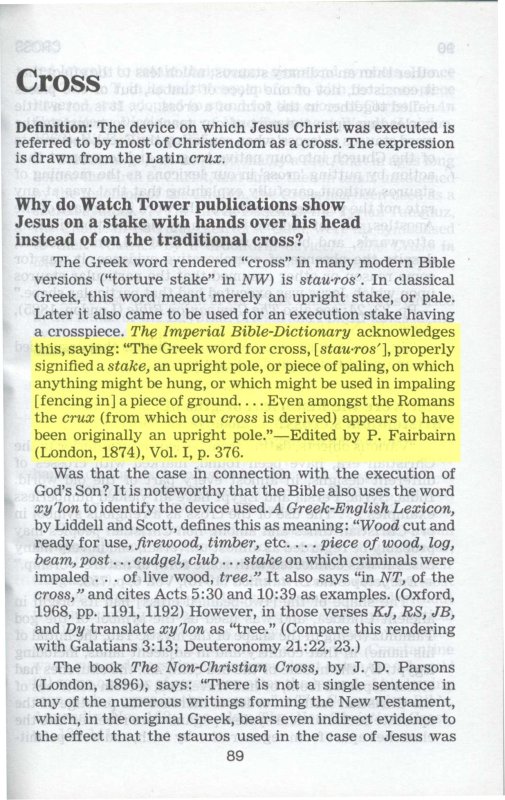 "The Greek word rendered "cross" in many modern Bible versions ("torture stake" in NW) is stau·ros´. In classical Greek, this word meant merely an upright stake, or pale. Later it also came to be used for an execution stake having a crosspiece. The Imperial Bible-Dictionary acknowledges this, saying: "The Greek word for cross, [stau·ros´], properly signified a stake, an upright pole, or piece of paling, on which anything might be hung, or which might be used in impaling [fencing in] a piece of ground. . . . Even amongst the Romans the crux (from which our cross is derived) appears to have been originally an upright pole."-Edited by P. Fairbairn (London, 1874), Vol. I, p. 376." Reasoning from the Scriptures p.89 What exactly has this quote hidden by use of ellipses (...)? The full quote is: 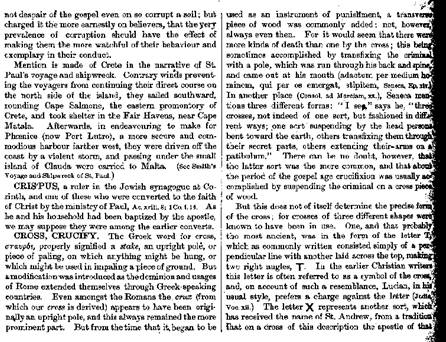 "The Greek word for cross, (stauros), properly signified a stake, an upright pole, or piece of paling, on which anything might be hung, or which might be used in impaling (fencing in) a piece of ground. But a modification was introduced as the dominion and usages of Rome extended themselves through Greek-speaking countries. Even amongst the Romans, the crux (from which the word cross is derived) appears to have been originally an upright pole, and always remained the more prominent part. But from the time that it began to be used as an instrument of punishment, a traverse piece of wood was commonly added: not however always then. … There can be no doubt, however, that the later sort was the more common, and that about the period of the Gospel Age, crucifixion was usually accomplished by suspending the criminal on a cross piece of wood. … But the commonest form, it is understood, was that in which the upright piece of wood was crossed by another near the top, but not precisely at it, the upright pole running above the other, thus "a cross" and so making four, not merely two right angles. It was on a cross of this form, according to the general voice of tradition, that our Lord suffered. ... It may be added that crucifixion was abolished around the time of Constantine, in consequence of the sacred associations which the cross had now gathered around it." The Imperial Dictionary shows quite the opposite of what the Watchtower attempts to prove. Rather than supporting that crucifixion did not come until after Jesus death and that Constantine who introduced this pagan symbol, it specifically states that crosses were the prominent form of execution in Jesus day, and it was Constantine that put an end to them. The Reasoning Book on page 89 goes on to quote "The book The Non-Christian Cross, by John Denham Parsons" for support that Jesus did not die on a stake. Exactly who is this writer that the reader should trust his opinion over other scholars. John Parsons was a Skeptic who also wrote Our Sun-God: Or Christianity before Christ trying to prove a connection between Jesus and the Egyptian God Horus, wrote information attempting to show Shakespeare did not write Shakespeare, and was a member of the Society for Psychical Research to promote information on psychics and the paranormal. The research provided by Parsons regarding crux is quite flawed. For instance, he quotes Livy as using crux to mean stake (Livy, xxviii. 29) but was mistaken. Livy used the word palus not crux in this passage - "Bound to a stake (deligati adpalum) they were scouraged and beheaded" (28.29.11). Parsons also quotes Lucian saying Jesus was "fastened to a skolops;" (De Morte Peregrini) and claims Lucian used skolops to mean a single piece of wood. Yet this too is wrong, as Lucian uses the same verb anaskolopizoó in Lis Consonantium, 12 to refer to crucifixion on a two-beamed stauros. Another source the Watchtower uses to indicate Jesus died on a stake is the 16th century De Cruce Liber Tres by Justus Lipsius. The Appendix to the 1950 and 1969 editions of The New World Translation and the Kingdom Interlinear reproduces a woodcut illustration by Lipsius of a stake. The Appendix then states "This is the manner in which Jesus was impaled", giving the distinct impression that Lipsius supports Jesus death on a stake. (This was changed in the 1984 edition to read "The photograph of the crux simplex on our p.1578 is an actual reproduction from his book."  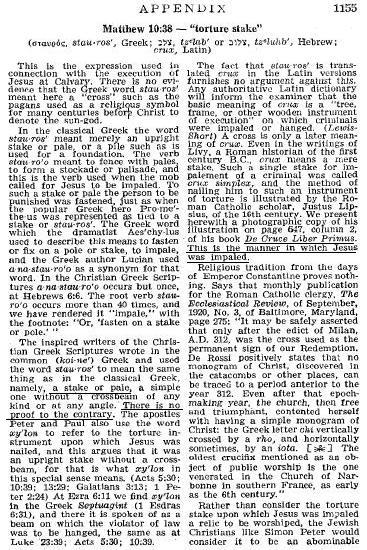 A 1980 Watchtower article attempts to give the same impression that Lipsius supported a stake. "Whether the wooden sculpture is the work of the 16th-century artist Michelangelo or not, it illustrates that the impalement of Christ on a cross frame has not always been so certain as Christendom’s leaders today would have people believe. For example, the 16th-century Roman Catholic scholar Justus Lipsius illustrated impalement on an upright stake in his book “De Cruce Liber Primus.” This fits the meaning of the Greek word used in the Bible to describe the impalement of Christ." Watchtower 1980 Feb 15 p.30 What is not mentioned is that Lipsius taught that Jesus died on a cross. His book included a total of 16 such woodcuts, 9 depicting various forms of crucifixion. Under one of the crucifixion woodcuts is inscribed (translated from Latin) "In the Lord's cross there were four pieces of wood, the upright beam, the crossbar, a tree trunk placed below, and the title placed above." 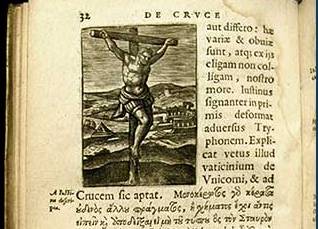 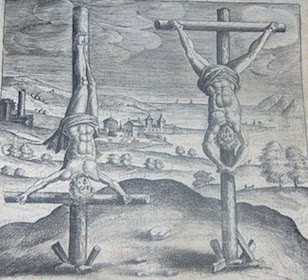 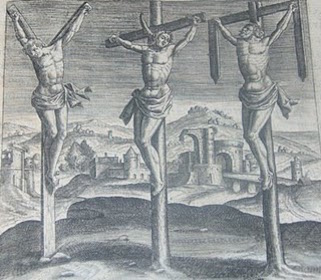 Once again, one of the few Watchtower references provided to support Jesus' death on a stake is used fraudulently and actually stated that Jesus died on a cross. |
| Re: Part 1: Questionable Doctrine Of JW: Did Jesus Die On A Cross Or Stake? by ChristianFreedo(m): 5:58pm On Sep 22, 2016 |
Pagan The Watchtower regularly uses the illogical and contradictory argumentation of paganism to prevent Jehovah's Witnesses from engaging in common practices. For instance, confetti cannot be thrown at a wedding because it is "pagan" (despite few people having any idea of what the pagan meaning and origins may be) but the Watchtower allows the use of the "pagan" wedding ring. Likewise, the assertion is made that the cross was not used by 'true Christians' and is of pagan origins. "The fact that the cross is of pagan origin only makes the matter worse. The veneration of the cross is not Christian. It does not show love for God or Christ but mocks what they stand for. It violates God's commandments against idolatry. It reveres a pagan symbol masquerading as Christian. (Exodus 20:4, 5; Psalm 115:4-8; 1 Corinthians 10:14) To consider a pagan symbol as sacred violates God's command: "Do not become unevenly yoked with unbelievers. For what fellowship do righteousness and lawlessness have? . . . 'Quit touching the unclean thing.'"" Watchtower 1989 May 1 p.26 This is a fallacious argumentation, a form of non sequitur. Christians use a cross in remembrance of Jesus Ransom, not as association with pagan gods. It is true that pagan religions have used various forms of the cross, but it does not follow that this makes use of the symbol wrong. Cats were worshipped as gods by the Egyptians but this is not a reason for Christians to avoid cats. The cross was a common form of Roman torture, not because of any pagan connotation, but because of it being an effective way to prolong the agony of death. What makes the argument of the cross being pagan all the more illogical is that a stake or pole has a greater sexual and hence pagan connotation than the cross. In Christian times the phallus was represented by the pole shaped Obelisk of the Egyptians and Romans and the Hindu Lingam. Sacred poles are often mentioned in the Bible, such as at Exodus 34:13; "But their altars YOU people are to pull down, and their sacred pillars YOU are to shatter, and their sacred poles YOU are to cut down." If Watchtower wants to find pagan concepts in the death of Jesus they need look no further than their own teaching of a stake. Jesus death on a stake mimics the ancient Sumerian myth of Inanna. Inanna descended into the nether world. There she was turned into a corpse by the seven judges and "the corpse was hung from a stake" for three days and nights. After this she was resurrected by the instructions of Enki, the god of fertility. (The Hero with a Thousand Faces, Joseph Campbell, 1973, See also Mythology A Visual Encylopedia, Jo Forty 1999) If a symbol should be rejected on the grounds of pagan roots, consider the symbol of the Watchtower Society.  Click here for the picture of Artemis in full, courtesy of Dictionary of the Bible McKenzie, John L. The Bruce Publishing Company 1965, page 58. The Canaanite alter is from the Rockefeller Museum, Number 251 in the Gallery Book, picture courtesy of Tim Bulkeley. Watchtower is also a Wiccan term used in witchcraft. The Guardians of the Watchtower represent the four elements, air, fire, water and earth, invoked during ritual to cast the magic circle. (See The Complete Idiot's Guide to Wicca and Witchcraft, D. Zimmerman, 3rd Edition p.187) "Watchtower" tablets are used in Enochian magic, developed by John Dee and Edward Kelley in the sixteen century and furthered by Alistair Crowley in the 19th century. "The Watchtower structure is probably the most familiar part of Enochian magick. It has been popularized by the Golden Dawn and its descendants." (System of Enochian Magick 17 Feb 2016) It is used in evocation, the act of calling upon or summoning a demon. |
| Re: Part 1: Questionable Doctrine Of JW: Did Jesus Die On A Cross Or Stake? by ChristianFreedo(m): 6:36pm On Sep 22, 2016 |
Idolatry Watchtower claims Christian use of the cross constitutes idolatry. “Moreover, the Bible strongly warns Christians to “flee from idolatry,” which would mean not using the cross in worship.” Why Don’t Jehovah’s Witnesses Use the Cross in Their Worship? (2013-09-09) [See: http://www.jw.org/en/jehovahs-witnesses/faq/cross-belief] Far from being introduced as a pagan idolatrous symbol, the cross was used as a Christian symbol to prevent pagan idolatry. In The Australian Financial Review Dec. 21 2005 an article entitled "The Mandylion Mystery" by Dan Goddard explains why no one is sure what the face of Jesus looked like. A depiction of Jesus was never used, with symbols such as the cross used instead, in an attempt to prevent pagans idolising his image: “But do we really know what Jesus looked like? The Bible offers scant description, even by the disciples, and for more than 300 years after his crucifixion church authorities forbade images of him to be created, fearing that pagans would use a depiction of Christ as an idol. Instead, symbols were used: a ship, the ark of salvation, or a cross and a fish.”  Watchtower claims: “self-sacrificing love—not the cross or any other image—would identify his true followers.” Why Don’t Jehovah’s Witnesses Use the Cross in Their Worship? (2013-09-09) [See http://www.jw.org/en/jehovahs-witnesses/faq/cross-belief] Yet there is little difference between Christians using a cross as a form of identification and the way Jehovah's Witnesses use images of jw.org and the Watchtower logo. Whilst the cross is a powerful and respectful reminder of Jesus, Watchtower veneration of the jw.org logo is cheap marketing of an organisation. |
| Re: Part 1: Questionable Doctrine Of JW: Did Jesus Die On A Cross Or Stake? by ChristianFreedo(m): 6:45pm On Sep 22, 2016 |
Conclusion Paul showed that we should proudly boast about Jesus death on the cross. Its use is constant reminder of the importance of the ransom to our everlasting existence. Galatians 6:14 "Never may it occur that I should boast, except in the torture stake [cross] of our Lord Jesus Christ, through whom the world has been impaled [crucified] to me and I to the world." 1 1 Medical evidence, Biblical passages, the Ante-Nicene Fathers, history and Archaeology all identify that Jesus died on a cross. Linguistics supports that stauros meant cross prior to the first century. The cross is not pagan as it was identified with early Christianity. It is untrue to say it was introduced 300 years after Christ by Constantine. That some Christians have misused the cross as a symbol for worship is not reason to reject accurate history. The Watchtower originally used the cross, not as a form of idolatry, but rather as an accurate historical symbol to keep in the forefront of ones mind the importance of the Ransom. The thrust of Rutherford's preaching was strong anti-Catholicism and during his tenor as President of the Watchtower Society he tried to disassociate Jehovah's Witnesses from as much of Christianity as possible. It would appear that Jehovah's Witnesses have changed their teachings to a stake, not on historical or biblical evidence, but for the sake of segregation. To be concerned that a cross may encourage idolatry for some Witnesses shows a lack of faith in the motives of the members. Most people do not worship the cross itself but use it as a reminder of Jesus. Adhering to truthfulness would dictate that Christians recognise that Jesus died on a cross as a Ransom sacrifice for the sins of mankind. Footnote: 1. The New World Translation rendering of Galatians 6:14 is an example of poor and misleading translation, as there is no justification for inserting the word "torture", the Greek phrase used is simply "en stauros". |
| Re: Part 1: Questionable Doctrine Of JW: Did Jesus Die On A Cross Or Stake? by ChristianFreedo(m): 6:47pm On Sep 22, 2016 |
JMAN05, DoctorAlien, joyandfaith, oneolajire, MamuzoADUMS, SirWere |
| Re: Part 1: Questionable Doctrine Of JW: Did Jesus Die On A Cross Or Stake? by DoctorAlien(m): 7:42pm On Sep 22, 2016 |
It is rather unfortunate that JWs are actively teaching doctrines that are not biblical. Just imagine replacing the word "cross" with "stake" in the Bible. One doesn't need to read much to know that the cross was a common execution tool employed by the first century AD Romans. |
| Re: Part 1: Questionable Doctrine Of JW: Did Jesus Die On A Cross Or Stake? by joyandfaith: 3:49am On Sep 23, 2016 |
THE cross is loved and respected by millions of people. The Encyclopædia Britannica calls the cross “the principal symbol of the Christian religion.” Nevertheless, true Christians do not use the cross in worship. Why not? An important reason is that Jesus Christ did not die on a cross. The Greek word generally translated “cross” is stau·rosʹ. It basically means “an upright pale or stake.” The Companion Bible points out: “[ Stau·rosʹ ] never means two pieces of timber placed across one another at any angle . . . There is nothing in the Greek of the [New Testament] even to imply two pieces of timber.” In several texts, Bible writers use another word for the instrument of Jesus’ death. It is the Greek word xyʹlon. ( Acts 5:30; 10:39; 13:29; Galatians 3:13; 1 Peter 2:24 ) This word simply means “timber” or “a stick, club, or tree.” Explaining why a simple stake was often used for executions, the book Das Kreuz und die Kreuzigung (The Cross and the Crucifixion), by Hermann Fulda, states: “Trees were not everywhere available at the places chosen for public execution. So a simple beam was sunk into the ground. On this the outlaws, with hands raised upward and often also with their feet, were bound or nailed.” The most convincing proof of all, however, comes from God’s Word. The apostle Paul says: “Christ purchased us, releasing us from the curse of the Law by becoming a curse instead of us, because it is written: ‘Accursed is every man hung upon a stake [“a tree,” King James Version].’” ( Galatians 3:13 ) Here Paul quotes Deuteronomy 21:22, 23, which clearly refers to a stake, not a cross. Since such a means of execution made the person “a curse,” it would not be proper for Christians to decorate their homes with images of Christ on a cross. There is no evidence that for the first 300 years after Christ’s death, those claiming to be Christians used the cross in worship. In the fourth century, however, pagan Emperor Constantine became a convert to apostate Christianity and promoted the cross as its symbol. Whatever Constantine’s motives, the cross had nothing to do with Jesus Christ. The cross is, in fact, pagan in origin. The New Catholic Encyclopedia admits: “The cross is found in both pre-Christian and non-Christian cultures.” Various other authorities have linked the cross with nature worship and pagan sex rites. Why, then, was this pagan symbol promoted? Apparently, to make it easier for pagans to accept “Christianity.” Nevertheless, devotion to any pagan symbol is clearly condemned by the Bible. ( 2 Corinthians 6:14-18 ) The Scriptures also forbid all forms of idolatry. ( Exodus 20:4, 5; 1 Corinthians 10:14 ) With very good reason, therefore, true Christians do not use the cross in worship. * https://www.jw.org/en/publications/books/bible-teach/origin-cross-symbol-pagan/ |
| Re: Part 1: Questionable Doctrine Of JW: Did Jesus Die On A Cross Or Stake? by joyandfaith: 3:54am On Sep 23, 2016 |
Babylon Mystery Religion :“Ages ago in Italy, before the people knew anything of the arts of civilization, they believed in the cross as a religious symbol. It was regarded as a protector and was placed upon tombs. In 46 B.C., Roman coins show Jupiter holding a long scepter terminating in a cross. The Vestal Virgins of pagan Rome wore the cross suspended from their necklaces, as the nuns of the Roman Catholic church do now” (p. 51). |
| Re: Part 1: Questionable Doctrine Of JW: Did Jesus Die On A Cross Or Stake? by rottennaija(m): 8:21am On Sep 23, 2016 |
joyandfaith: I'm sure you never bothered to read the article. Check the article again and check the bolded from your post. There are ample and enough evidence and the Watchtower isn't showing the prove |
(1) (Reply)
MMM: You Have Been Warned / Help!!!! Can God Ever Forgive Me. I'm A Bad Person.. / Scientist Stephen Hawking Dies Aged 76
(Go Up)
| Sections: politics (1) business autos (1) jobs (1) career education (1) romance computers phones travel sports fashion health religion celebs tv-movies music-radio literature webmasters programming techmarket Links: (1) (2) (3) (4) (5) (6) (7) (8) (9) (10) Nairaland - Copyright © 2005 - 2024 Oluwaseun Osewa. All rights reserved. See How To Advertise. 188 |